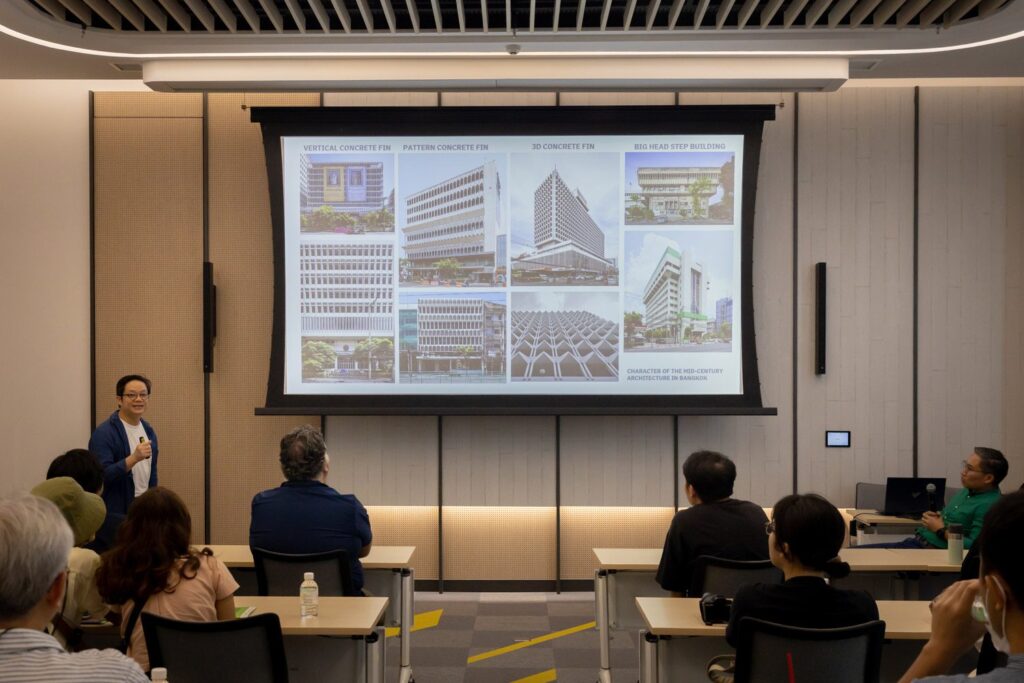SPACE SEEKING – SOUTH SUKHUMVIT ARCHITECTURAL TOUR
The existence of True Digital Park and the emergence of Cloud 11 undoubtedly confirm that the southern part of Sukhumvit Road is destined to become a vital economic hub of Bangkok in the future. Simultaneously, the area, now increasingly referred to as ‘South Sukhumvit,’ is filled with an intriguing past, particularly concerning the stories revolving around modern architecture in Thailand, which is currently at a critical juncture in the face of impending changes brought about by the winds of urban development.
During the recent Bangkok Design Week, on February 3, art4d collaborated with Creative Lab from MQDC and Cloud 11 to organize the event ‘SPACE SEEKING – South Sukhumvit Architectural Tour.’ This project aimed to lead those interested in architecture and history on an exploration of modern architectural works in the South Sukhumvit area (covering districts from Phra Khanong to Bang Na).
Weerapon Singnoi, an architectural photographer and the owner of the foto_momo page, carefully selected each and every building featured on the tour’s program. Joining the walk were speakers who are experts in the field of architecture and urban development, including Salyawate Prasertwitayakarn, an architect and founder of Atelier of Architects, along with Boonchai Tienwang, the Managing Director of Stonehenge.
Simply speaking, this project is an exploration driven by attentive consideration of the past because there is nothing more regrettable than losing a part of the past without ever knowing anything about it.

Upon the start of the tour, Salyawate and Boonchai gave a brief introduction at True Digital Park, laying the groundwork for participants to navigate the cityscape in a more engaging and knowledgeable manner. They gave a general overview of Bangkok before going into more detail about South Sukhumvit’s urban and architectural landscape.
This included insights into population density, public transportation systems, green spaces, and other relevant aspects. The historical background of the area was also mentioned, encompassing the establishment of numerous pharmaceutical factories around 1967. This period marked a pivotal moment preceding the evolution of architecture in Thailand, extending from the mid-century era to the present day.
The introductory talk concluded by delving into the historical aspect and highlighting distinctive elements of modern architecture as well as prominent features of Brutalist architecture, such as façade designs and materials. The intention behind the introduction was to assist participants in connecting the past to the present, fostering a deeper understanding of the fundamental aspects associated with each of the buildings they were about to explore.

The first stop on the tour is the Phihalab Building (1960), which once served as both the office and pharmaceutical manufacturing facility for the Udomphon Company. Designed by Professor Dr. Ruangsak Kantabutra, the first Thai individual to study under Ludwig Mies van der Rohe, the structure stands out for its architectural efforts to adapt to Thailand’s climate.
Such an endeavor is evident in the design of walkways surrounding the functional area and the incorporation of an additional façade layer on the exterior, which serves to protect against both rain and sunlight. The inner side of the façade was meticulously designed in a calculated sequence and constructed with aluminum, a rare building material at the time. This is particularly noteworthy as it distinguishes the building from others predominantly constructed from concrete.

Another distinctive feature of the building is its expansive drop-off area at the front, showcasing the waffle slab structure and highlighting the intersection of engineering prowess with aesthetic dimensions. While the tour did not delve into the interior details this time, the Phihalab Building has been periodically opened to the public, providing architectural enthusiasts with a closer look at its unique features. Collective by Cloud11, held last year, was among the events granted special access to explore this architectural gem.







